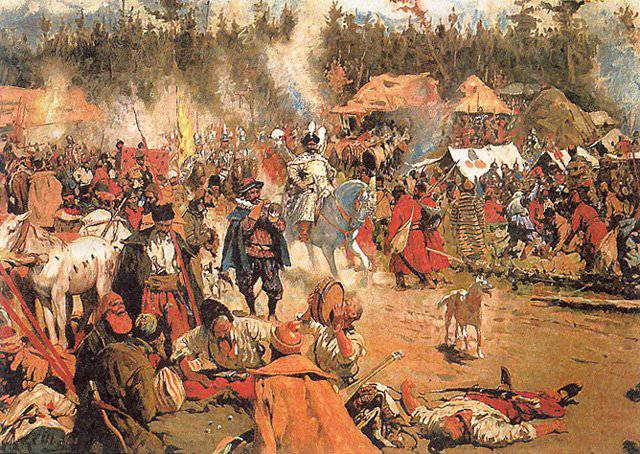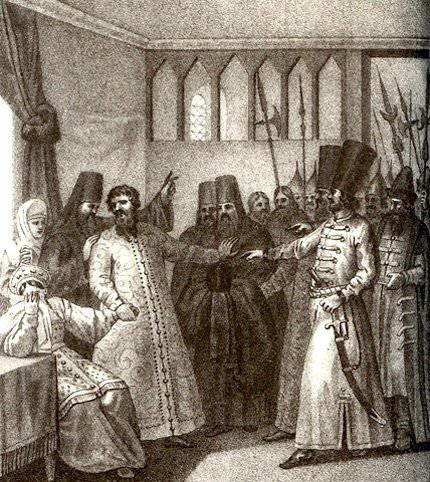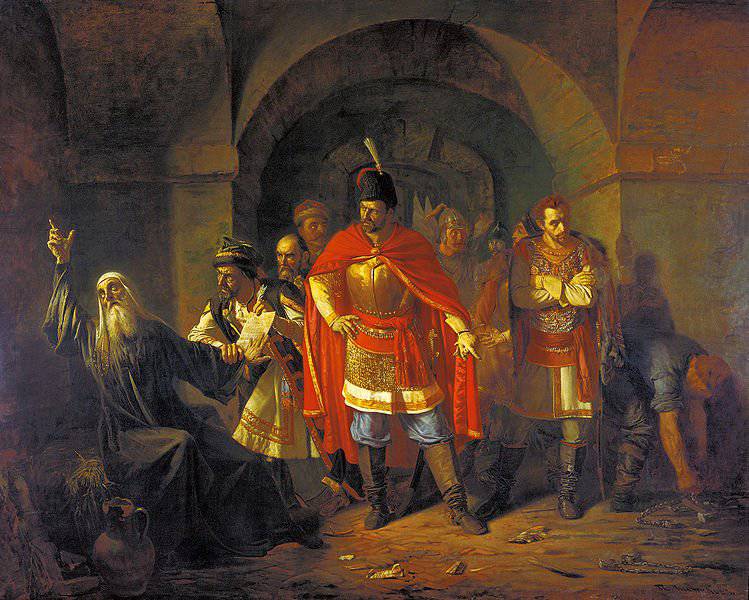Time of Troubles and the Cossacks. 2 part
As a result, the impostor himself facilitated the preparation of the coup, the boyar childbirth was not going to endure an "upstart" over himself. Razgul, generous gifts (for six months from the royal treasury spent 7,5 million rubles, with an annual budget of 1,5 million), debauchery were characteristic features of his short reign. In April 1606 of the year, along with Yuri Mnishek and his daughter, a significant number of Poles arrived in Moscow - about 2 thousand people (noble gentry, lords, princes and their retinue). They behaved in a businesslike manner, outraged, bullied Muscovites and killed several people, raped women. The non-observance of the Moscow (Russian) traditions by the impostor and his bride caused great irritation.
As a result, residents of the city supported the conspirators - Vasily Shuisky, Vasily Golitsyn, Prince Kurakin and the most conservative clergy representatives - the Kazan Metropolitan Hermogenes and Kolomna bishop Joseph. Vasily Shuisky said bluntly that the impostor was “put on the kingdom” for the sole purpose of knocking down the Godunovs from the throne, but now it’s time to knock him too. 17 May 1606, an imposter during the uprising and hundreds of Poles were killed.
The king elected Basil Shuisky (1606-1610). Patriarch Ignatius, who was set up by the False Dmitry, was deposed, his place was taken by Hermogenes (according to one of the versions, he was descended from the Don Cossacks).
Continuation of the Troubles
The situation in the country after the murder of the first impostor did not stabilize. The false Dmitry and his entourage managed to discredit themselves only in the capital, for many in the provinces he was a “good king”, famous for his mercies and awards. There were rumors that Vasily Shuisky illegally took the throne, he was not even elected by the Zemsky Sobor.
Prince Shakhovsky and Mikhail Molchanov (one of the murderers of Fyodor Godunov) stole the royal press and, in the name of the “wonderfully saved” prince, began to call on the people to fight. In the middle of 1606, the Bolotnikov Uprising began in the southern regions, which was called the “royal commander”. Its center became Putivl, the governor of which was Prince Shakhovsky. In 1607, the “prince” appeared in Starodub (False Dmitry II, as well as the Tushinsky or Kaluga thief).
Cossacks actively participated in the new wave of the Troubles. In their opinion, Vasily Shuisky was not a legitimate king. In addition, the idea of impostors was very popular. More with False Dmitry I on the Terek Cossacks put forward "Tsarevich Peter" - in reality, the son of Tsar Fyodor Ivanovich never existed (it was Elika Muromets, real name Ilya Ivanovich Korovin). "Tsarevich" he was elected for the reason that he was the only one in Moscow and knew the order there. The Cossacks decided to go up the Volga and plunder the trade caravans, and the "prince" was needed to give the predatory campaign visibility legitimacy. 4-thousandth detachment of the Lower Cossacks went up the Volga. Tersky voevoda Peter Golovin and Astrakhan voivode Khvorostin could not stop them because of the unreliability of their forces, part of the Astrakhan garrison joined the "prince Peter". As a result, detachments of the Terek Cossacks and the Volga "thieves" joined the Bolotnikov uprising.
But in the end, Bolotnikov’s uprising was suppressed - the policy of terror against the nobility (slaves and peasants burned homesteads, killed landowners) pushed noblemen’s troops from the “governor”. The noble cavalry went over to the side of Vasily Shuisky: December 2 1606 Bolotnikov's troops were defeated near Moscow, 5 June 1607, the army of “Tsarevich Peter” was defeated near Kashira (in this battle the colors of the army of Peter Fedorovich were donned by the Terek, Volga and Volga Karas. hundreds). During June — October 1607, the Bolotnikov detachments, along with the remnants of the forces of Illey of Murom, held the defense of Tula, besieged by the troops of Tsar Vasily Shuisky. But on October 10, 1607 was forced to capitulate - because of the dam on the Upra River, which the royal troops built, the city was partially flooded and cut off from the outside world. The king promised "not to shed blood" of the rebels, but only nobles were spared. “Tsarevich” was hanged, Bolotnikov was drowned, ordinary prisoners, including Cossacks, were exterminated by hundreds, jammed with cudgels and lowered into the water (they kept the oath about “bloodlessness”).
Tushinsky thief
But the bloody end of the uprising of Bolotnikov and "Tsarevich Peter" did not stop the Troubles. The Cossacks were even more angry, Vasily Shuisky became their personal enemy. False Dmitry II gathered considerable forces and began to actively act.
There is also no exact information about him, according to one version, it was the priest’s son Matvey Verevkin from Seversk land, on the other - the son of Starodubsky archer, according to the third, the most popular is the Jew Bogdanko - a teacher from Shklov. The Poles, and his troops were strengthened by detachments of the princes Adam Vishnevetsky, Alexander Lisovsky, Roman Rozhinsky, did not care who to put on the throne when they opened up just fabulous prospects for robbery of Russia.
Ataman of the Don Cossacks Ivan Zarutsky, a participant in the war under the banner of the first False Dmitry and the Bolotnikov uprising, "recognized" the False Dmitry and confirmed his status by receiving the rank of "boyar". As a result, Polish adventurers, Cossacks, the remnants of the forces of Bolotnikov, part of the southern Russian nobility united around the second impostor. This was basically a professional army. In a two-day battle near Bolkhov on April 30 - May 1, the army of the impostor defeated the forces of Shuisky (under the command of the Tsar brothers, Dmitry and Ivan). In early June, the False Dmitry II forces approached Moscow and camped in Tushino, which is why he was called the Tushino thief.
25 July Vasily Shuisky concluded an agreement with the ambassadors of the Polish king Sigismund III. According to him, Poland has withdrawn all the supporters of the second impostor of the Poles, Marina Mniszek should not recognize Falsdmitry as her husband, not to call herself the Russian Empress. But Rozhinsky and other Polish feudal lords refused to give up the work begun by them, on the contrary, the impostor's army continued to replenish the Poles. In the fall of 1608, came with his people Jan Sapega. The Mnishekov family were beaten off on the way to Poland: after long negotiations, Yuri Mnishek agreed to recognize the impostor as his son-in-law, but only by receiving a receipt that the False Dmitry, having received full power in the country, would give Yuri 30 thousand rubles. and the Seversky principality with 14 cities.
From this time begins the dual power in the country. Tushino for a time became one of the capitals of Russia, to which a significant part of the territory of the Russian state was subordinate. They built a whole city with a "royal" palace. A part of the nobility ran over to the impostor, and some of them regularly changed their position; a “boyar duma” led by Mikhail Saltykov and Dmitry Trubetskoy arose. Filaret Romanov was made his patriarch. Although in reality the Poles had all the power, for them the impostor was only a covering figure.
The situation was aggravated by a number of serious foreign policy mistakes by Vasily Shuisky: He asked for help from the Crimean Khan, and he “helped” - the horde ravaged the environs of Serpukhov, Kolomna, Ryazan and left, leading many thousands full. The citizens began to curse Shuisky for "bringing the unclean." Then he asked for help to Sweden, and the Swedes "helped" - they imposed a contract according to which Russia ceded to Korela with the county, paid a lot of money for the mercenary army. But the Swedes did not send their troops, but hired soldiers in Europe, they rebelled after the first serious clashes and turned back. And Sweden was at war with Poland, Sigismund took advantage of the excuse and declared war on Moscow. In 1609, the Polish army laid siege to Smolensk, only the feat of its defenders saved Russia from the invasion of Polish troops in other areas. Russia was threatened by Polish occupation - at that time Poland was a great power in Europe. Polish court ideologist Palchevsky released a work in which the idea that Russia should become the “Polish New World” was justified; Russian heretics should be converted to Catholicism and become slaves of the Polish empire, following the example of the Indians in America.
During this period, the Cossacks mostly fought on the side of the Tushino thief and the Poles. The 10-thousandth detachment of Zaporozhians under the leadership of atamans Shiryay and Nalyvayko arrived at Sigismund near Smolensk.
But the second impostor did not justify the hopes of the people: the Poles cleaned the cities, collecting "salary", killed, dishonored people, defiled the churches. Cities began to fall away from False Dmitry. Sigismund called the Polish troops near Smolensk. The siege of the Trinity-Sergius Monastery ended in failure - from September 23 1608 to January 12, 1610. Moscow could not take. The impostor, fearing that he would be killed, fled to Kaluga in December 1609, and called to kill the Poles, declaring them to be traitors. The Cossacks also split, a smaller part went with Smolensk to chieftain Zarutsky, under the arm of the Polish king (although he soon returned to the thief of Tushino, having quarreled with the Poles), most went to Kaluga.

S.V. Ivanov. "In the Time of Troubles".
Betrayal of the boyars. Hermogenes feat
The defeat of the troops of Dmitry Shuisky near Klushin from the Polish army 24 June 1610, the mistakes of Vasily on the throne led to a new uprising in Moscow. 17 (27) July 1610, part of the boyars, the capital and provincial nobility overthrew Vasily IV Ivanovich from the throne and was forcefully monk. In September, the former tsar was given 1610 to the Polish hetman Zolkiewski, who took Vasily and his brothers Dmitry and Ivan in October near Smolensk, and later on to the territory of Poland. He died in Polish custody in September 1612 of the year.

"Vasily Shuisky's monastic vows", picture by B. Chorikov.
The capital was managed by a group of seven boyars led by Prince Fyodor Ivanovich Mstislavsky, this period was called the “Seven Boyars” (1610-1613). One of the first decisions of the boyar group - it included the princes Ivan Vorotynsky, Andrei Trubetskoy, Andrei Golitsyn, Boris Lykov-Obolensky, the boyars Ivan Romanov (younger half-brother of Patriarch Philaret and uncle of the future first Tsar of the Romanovs, Mikhail Fedorovich) and Fyodor Sheremetev - the decision not to elect a representative from the Russian clans as king. Each clan considered itself worthy of such an honor, so they could not agree. In reality, the power of the Seven Boyars did not extend beyond the capital. In the west of the city, in Khoroshevo, the Polish detachments led by Zolkiewski rose, and in the southeast, in Kolomenskoye, an impostor who had returned from Kaluga, with whom there was also a Polish detachment of Sapegi. The false Dmitry II was most feared by the boyars, because he had many supporters in the capital and was more popular than they.
As a result, it was decided to agree with the Poles and invite the Polish throne to the Russian throne, Vladislav of Poland, setting a condition for his conversion to Orthodoxy, the new tsar had to keep faith, laws, traditions and territorial integrity of the country intact. Sigismund had a similar agreement with the Tushino delegation. 17 (27) August 1610, the corresponding agreement was signed between the boyars and hetman Zolkiewski. Moscow kissed the cross to prince Vladislav. However, fearing the second impostor, “Semiboyarshchina” went further, and on the night of September 21 Polish troops were let in to Moscow. After that, the power in Moscow actually passed to the commander of the Polish garrison, Alexander Gonshevsky.
Patriarch Hermogenes, who was an ardent opponent of the boyar government and a supporter of the election of the king of the Russian clan, was arrested. After that, he began to send out calls around the country to fight the Polish invaders. He blessed both militias, called them to free Moscow from the Poles. The letters that the Patriarch sent out to the cities and villages of the Russian state, aroused the people to liberate the capital from invaders, led to an uprising in Moscow itself. Patriarch placed in the Miracle Monastery in custody. The Poles sent ambassadors to Hermogenes several times demanding that he give instructions to the Russian militia to withdraw from Moscow, while threatening him with death. But this courageous man answered firmly: “What are you threatening me with? I am afraid of one God ... but if you stay here, I will bless everyone to stand against you and die for the Orthodox faith. " From the conclusion of the patriarch made a final appeal to the Russian people, blessing him in a holy war with the invaders. 17 February 1612 of the year, without waiting for the liberation of the capital, the old man died of starvation.

Pavel Chistyakov, "Patriarch Hermogenes in prison refuses to sign the letter of the Poles."
Information